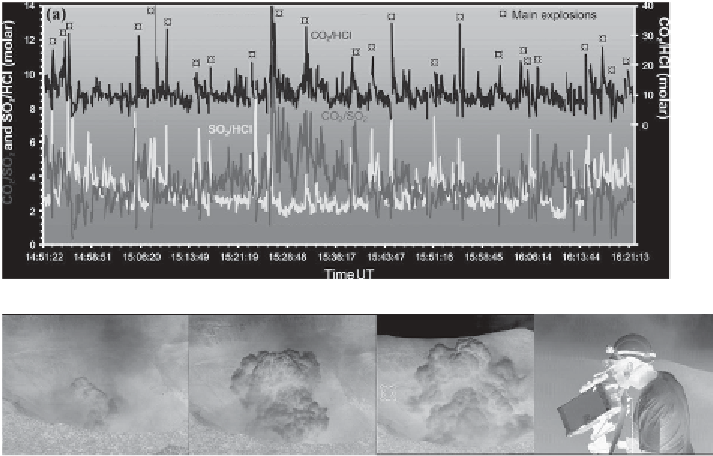Environmental Engineering Reference
In-Depth Information
(a)
(b)
Figure 6.3 (a) Open-path FTIR sensing of the gas composition at Yasur volcano
(Vanuatu) during (b) ash-rich explosive activity (courtesy of P. Allard; data from
Allard
et al
.,
2012
). A black and white version of this
figure will appear in some
illustrates the Multi-GAS results obtained during
field surveys at several
arc, hot-spot and rift-related volcanoes. Multi-GAS-based volcanic arc gas
compositions appear to span a far more restricted range than direct sampling
results would suggest (
Figure 6.2
), with an apparent cluster of gas samples
at CO
2
/S ratios of
~
2.0
0.5 (mean
standard deviation) and H
2
O/CO
2
ratios of
35
10. The implications of this observation are further discussed
in
Section 6.4.2
.
The main contribution of the Multi-GAS to volcanology is the demonstration
that fully automated systems can be deployed to make continuous, unattended,
near-real-time
~
field measurements of the compositions of gas plumes (Aiuppa
et al
.,
2007
,
2009
,
2010
; Shinohara,
2013
). Permanent Multi-GAS observations
have targeted measurements of CO
2
/SO
2
ratios of volcanic-gas plumes. Numerical
simulations of volcanic degassing suggest that high CO
2
/SO
2
ratios can be used to
track pre-eruptive degassing of more primitive (gas-rich) magma (Aiuppa
et al
.,
2007
). Continuing improvements in the temporal resolution of Multi-GAS instru-
mentation networks have allowed precursor cyclic changes in the volcanic-gas
CO
2
/SO
2
ratio to be systematically detected prior to basaltic eruptions (
Figure 6.5
)
(Aiuppa
et al
.,
2009
,
2010
).

